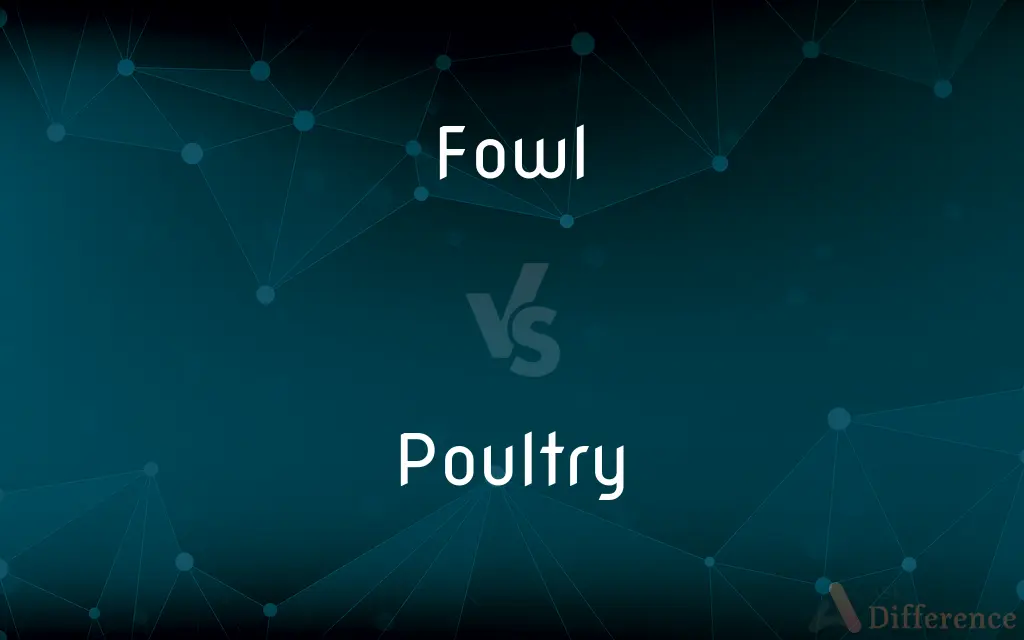Fowl vs. Poultry — What's the Difference?
By Urooj Arif & Fiza Rafique — Updated on March 29, 2024
Fowl generally refers to birds, specifically those wild or domesticated for hunting or eating, such as chickens or ducks. Poultry specifically denotes domesticated birds raised for their meat, eggs, or feathers, including chickens, turkeys, and quails.

Difference Between Fowl and Poultry
Table of Contents
ADVERTISEMENT
Key Differences
Fowl is a term that broadly encompasses birds, particularly those hunted or consumed as food. It includes both game birds, like pheasants and quails, and domesticated birds, such as chickens and ducks. The distinction within fowl often lies in their use or habitat, dividing them into wild and domestic categories. On the other hand, poultry exclusively refers to domesticated birds that are bred and raised on farms for their meat, eggs, or feathers. This category includes chickens, turkeys, ducks, geese, and more, emphasizing their role in agricultural and culinary contexts.
While all poultry can be considered fowl, not all fowl fall under the category of poultry. This distinction is crucial in understanding their different roles in human culture and cuisine. Fowl often connotes a broader, more inclusive category that can extend to non-domesticated birds, offering a wider range of culinary diversity. In contrast, poultry signifies a specific subset of domesticated birds that are an integral part of the global food industry, highlighting their economic and nutritional importance.
In culinary terms, the differentiation between fowl and poultry can influence the flavor, texture, and preparation methods of the birds. Wild fowl, for example, may offer a gamier taste and leaner meat due to their diverse diets and active lifestyles, while poultry tends to provide a more consistent and often fattier meat, given their controlled diets and farming conditions.
The terminology also reflects cultural and regulatory aspects of bird consumption. In legal and commercial settings, "poultry" is often used to denote birds that are subject to specific regulations regarding their breeding, sale, and processing. This regulatory framework ensures food safety and animal welfare standards are met, distinguishing them from wild fowl, which are regulated through hunting laws and conservation efforts.
Both fowl and poultry play significant roles in human diets and cultures worldwide, offering a range of nutritional benefits and culinary experiences. Their management, from conservation and hunting of wild fowl to the farming practices for poultry, reflects a balance between tradition, sustainability, and culinary innovation.
ADVERTISEMENT
Comparison Chart
Definition
Broad category of birds, including both wild and domesticated, used for food
Domesticated birds raised for meat, eggs, or feathers
Examples
Chickens, ducks, pheasants, quails
Chickens, turkeys, ducks, geese, quails
Use
Hunting and eating, with a distinction between wild and domesticated
Primarily raised on farms for agricultural production
Culinary Diversity
Offers a wider range of flavors and textures, from gamy wild birds to domesticated ones
Consistent flavors and textures, often tailored for specific culinary uses
Legal and Commercial Context
Encompasses birds under hunting and conservation regulations
Subject to agricultural regulations for food safety and animal welfare
Compare with Definitions
Fowl
Birds, especially those hunted or used for food.
The chef prepared a wild fowl dish using locally sourced pheasants.
Poultry
Subject to specific farming regulations.
Poultry farms must adhere to strict animal welfare standards.
Fowl
Can offer gamier meat.
Gourmet restaurants prize wild fowl for their distinct flavors.
Poultry
Raised for meat, eggs, or feathers.
Poultry products are staples in many diets, providing essential proteins.
Fowl
Reflects traditions of hunting and domestication.
The practice of rearing fowl dates back thousands of years.
Poultry
Domesticated birds raised for agricultural purposes.
The farm specializes in organic poultry, raising chickens and ducks for meat.
Fowl
Often used in a broader sense than poultry.
Regulations on hunting fowl ensure sustainable population levels.
Poultry
Includes chickens, turkeys, ducks, and geese.
Poultry farming is a significant industry worldwide.
Fowl
Includes both wild and domestic birds.
Fowl are essential to diverse culinary traditions around the world.
Poultry
Integral to global food supply.
Innovations in poultry farming have increased efficiency and sustainability.
Fowl
Fowl are birds belonging to one of two biological orders, namely the gamefowl or landfowl (Galliformes) and the waterfowl (Anseriformes). Anatomical and molecular similarities suggest these two groups are close evolutionary relatives; together, they form the fowl clade which is scientifically known as Galloanserae (initially termed Galloanseri) (Latin gallus (“rooster”) + ānser (“goose”)).
Poultry
Poultry () are domesticated birds kept by humans for their eggs, their meat or their feathers. These birds are most typically members of the superorder Galloanserae (fowl), especially the order Galliformes (which includes chickens, quails, and turkeys).
Fowl
A gallinaceous bird kept for its eggs and flesh; a domestic cock or hen.
Poultry
Domestic fowl, such as chickens, turkeys, ducks, and geese.
Fowl
Any of various birds of the order Galliformes, especially the common, widely domesticated chicken (Gallus domesticus).
Poultry
Domesticated fowl, such as chickens, turkeys, ducks, or geese, raised for meat or eggs.
Fowl
A bird, such as a duck, goose, turkey, or pheasant, that is used as food or hunted as game.
Poultry
Domestic fowl (e.g. chickens, ducks, turkeys, and geese) raised for food (either meat or eggs).
A poultry farmer
Fowl
The flesh of such birds used as food.
Poultry
The meat from a domestic fowl.
The poultry counter
Fowl
A bird of any kind.
Poultry
Domestic fowls reared for the table, or for their eggs or feathers, such as cocks and hens, capons, turkeys, ducks, and geese.
Fowl
To hunt, trap, or shoot wildfowl.
Poultry
A domesticated gallinaceous bird though to be descended from the red jungle fowl
Fowl
(archaic) A bird.
Poultry
Flesh of chickens or turkeys or ducks or geese raised for food
Fowl
A bird of the order Galliformes, including chickens, turkeys, pheasant, partridges and quail.
Fowl
Birds which are hunted or kept for food, including Galliformes and also waterfowl of the order Anseriformes such as ducks, geese and swans, together forming the clade Galloanserae.
Fowl
To hunt fowl.
We took our guns and went fowling.
Fowl
Any bird; esp., any large edible bird.
Let them have dominion over the fish of the sea, and over the fowl of the air.
Behold the fowls of the air; for they sow not.
Like a flight of fowlScattered by winds and high tempestuous gusts.
Fowl
Any domesticated bird used as food, as a hen, turkey, duck; in a more restricted sense, the common domestic cock or hen (Gallus domesticus).
Fowl
A domesticated gallinaceous bird though to be descended from the red jungle fowl
Fowl
The flesh of a bird or fowl (wild or domestic) used as food
Fowl
Hunt fowl
Fowl
Hunt fowl in the forest
Common Curiosities
Are all poultry considered domesticated?
Yes, all poultry are domesticated birds bred and raised under controlled farming conditions for their products.
Can the term "fowl" be used interchangeably with "poultry"?
While "fowl" can encompass poultry, it is not always interchangeable due to its broader inclusion of wild birds.
What regulatory differences exist between fowl and poultry?
Fowl, especially wild, are regulated by hunting laws and conservation efforts, while poultry farming is governed by agricultural regulations focusing on food safety and animal welfare.
What types of birds are considered wild fowl?
Wild fowl includes game birds like pheasants, quails, and wild ducks, which are often hunted for food.
How do culinary practices differ between fowl and poultry?
Culinary practices vary, with wild fowl offering gamier tastes and leaner meat, while poultry provides more consistent flavors and textures suited to a wide range of cooking methods.
What is the primary difference between fowl and poultry?
The primary difference lies in their scope; fowl includes a broader category of birds, including wild and domesticated, while poultry specifically refers to domesticated birds raised for food production.
How does the diet of fowl compare to that of poultry?
The diet of wild fowl is more varied and natural, affecting their meat's flavor and texture, whereas poultry's diet is controlled to optimize growth and meat quality.
Are there environmental considerations in managing fowl and poultry populations?
Yes, sustainable management of wild fowl populations involves conservation and regulated hunting, while poultry farming focuses on minimizing environmental impact and enhancing animal welfare.
How do fowl contribute to biodiversity?
Fowl, particularly wild species, contribute to biodiversity through their roles in ecosystems, including seed dispersal and serving as prey for other wildlife.
Why is poultry preferred over wild fowl in commercial food production?
Poultry is preferred due to its consistent quality, ease of farming, and ability to meet global food demands efficiently.
Share Your Discovery

Previous Comparison
Ranch vs. Plantation
Next Comparison
Perfusion vs. ProfusionAuthor Spotlight
Written by
Urooj ArifUrooj is a skilled content writer at Ask Difference, known for her exceptional ability to simplify complex topics into engaging and informative content. With a passion for research and a flair for clear, concise writing, she consistently delivers articles that resonate with our diverse audience.
Co-written by
Fiza RafiqueFiza Rafique is a skilled content writer at AskDifference.com, where she meticulously refines and enhances written pieces. Drawing from her vast editorial expertise, Fiza ensures clarity, accuracy, and precision in every article. Passionate about language, she continually seeks to elevate the quality of content for readers worldwide.














































